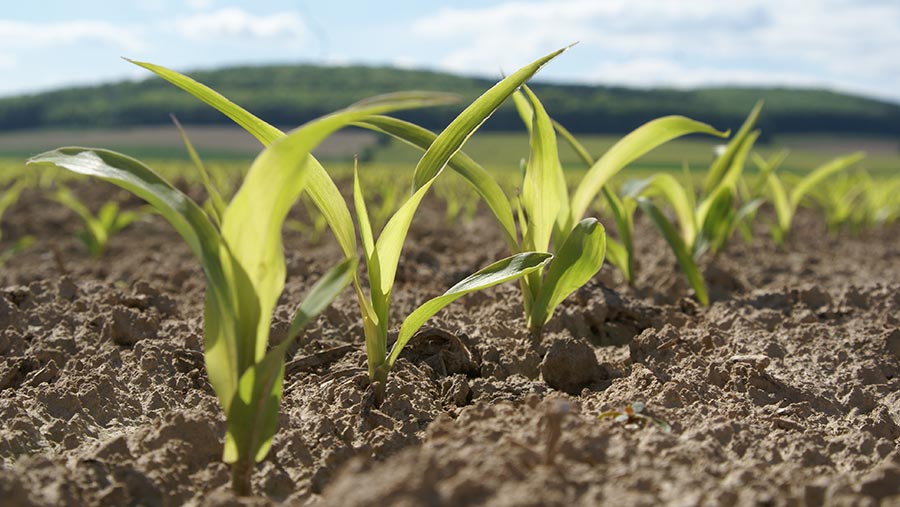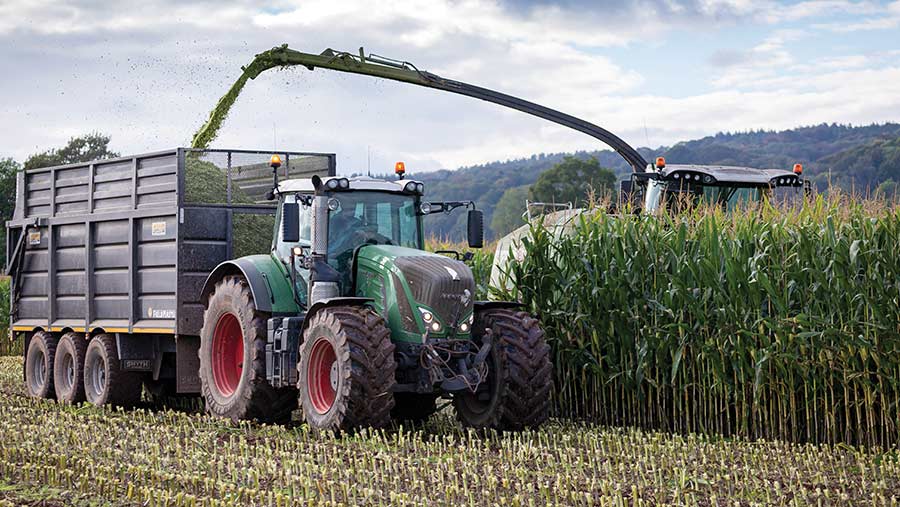5 ways to reduce the carbon footprint of maize production
 Cold soils can hamper establishment, and this poor start affects the whole season © KWS
Cold soils can hamper establishment, and this poor start affects the whole season © KWS Managing maize production as efficiently as possible offers UK growers one of the biggest opportunities to minimise the carbon footprint of their forage production.
Dairy and beef sectors are increasingly looking for carbon audits of feeds used on-farm.
Dairy co-operative Arla, for example, says 83% of its carbon footprint is directly related to on-farm decisions made by its milk suppliers.
Of this, 33% can be attributed to feed production, including emissions from home-grown feed.
See also: How feeding maize silage has cut ration cost by £10 a ewe
Farmers Weekly asks five specialists for their tips on how best to produce a maize crop with the lowest possible carbon footprint.
1. Choose the best variety for the job
KWS technical maize specialist Andrew Cooke says selecting varieties for specific growing situations is one of the most important factors in making best use of individual resources and reducing the need for additional inputs.
“The less you need to put in, the lower the carbon footprint of your production. [And] the higher the output, the lower the carbon footprint per tonne of production,” he says.
This means choosing a variety matched precisely to its end use and to the heat units available in a particular locality.
Early and ultra-early maturing varieties take less time, heat units and light exposure to mature and produce higher levels of starch than later maturing varieties.
“Maize producers who drill early are probably the ones seeing the most variable results in the field and the clamp,” he says.
“Cold soils can hamper germination and establishment, and this poor start is then carried through the season.
“Growers choosing ultra-early varieties drilled at the correct soil temperature – 8C in lighter soils and 12C in heavier soils – generally achieve the best results.”

It’s essential to match the variety to the growing conditions © KWS
2. Give the crop a cracking start
Crop Advisors independent agronomist Howard Nason says overuse of steel and diesel for cultivations contributes heavily to the carbon footprint of maize production.
Well-structured soil should not need subsoiling or ploughing before drilling maize.
Instead, cultivations should be targeted to alleviate any compaction and create a seed-bed conducive to rapid establishment.
“Maize is the one crop that will show up any form of soil compaction, so any tramlines or heavy traffic areas of the field need to be dealt with pre-drilling,” he says.
“Dig a hole to find the compaction depth and set the subsoiler point 2.5cm below the compacted soil. This will give optimum lifting of the soil.
“Where moisture is not limiting, seed-beds can be left unrolled to help with water infiltration through the soil profile and avoid the risk of capping.”
He advises aiming for a seed-bed that is good enough to allow any planned pre-emergence weed control to be effective, while not being overworked.
Effective weed control to reduce competition is also important, says Andrew.
“With the trend towards later drilling often resulting in larger numbers of weeds in seed-beds, pre-emergence herbicides are a very worthwhile investment.
“They also provide a wider window for the application of a subsequent post-emergence spray.”
N applications once the crop is growing are not usually needed, he adds, particularly if full use of organic sources has been made.
Peak demand is from the six- to eight-leaf growth stage until early cob formation, which typically covers a 40- to 50-day period.
Farmyard manure (FYM) helps feed the crop during this time as mineralisation increases with rising soil temperatures.
3. Get crop nutrition spot on
By using FYM and slurry on maize crops, carbon produced on the farm is continuously recycled, says Allison Arden, agronomy manager of independent crop analysis specialist NRM.
“Fertiliser manufacture contributes around 60-70% of the carbon footprint of growing a crop. The more we can reduce our reliance on this and get the natural soil system functioning, the more efficient our farming system will become.”
She advises careful management and targeted applications of organic fertilisers to ensure they address nutrient needs without impacting on the environment.
For soils with an index of 0 for phosphate (P), she suggests applying 115kg/ha a year to maintain target values. For potash (K), 235kg/ha should meet crop need and build the index towards maintenance index 2.
“Maize is a large, hungry crop that removes a lot of nutrients from the system every time it is harvested,” she says, adding that maize silage at 30% dry matter (DM) removes 1.4kg P and 4.4kg K for every tonne harvested.
“If you’re harvesting a 50t/ha crop, you’re removing 70kg/ha of P and 220kg/ha of K from the soil, so it’s very easy to see how indices can reduce, particularly if your indices are suboptimal to start with.
“If suboptimal indices are not managed, they can create a legacy of poor soil nutrient supply for following crops.”
Soil sampling is “an absolute must” to ensure the correct volume of organic material is applied, based on its nutrient status and the soil indices. Alison advises rotational testing of 25% of productive land each year.
FYM should be incorporated within 24 hours of application. By shallow injecting slurry and digestate, the available nutrient supply increases and ammonia emissions reduce.
“Keeping the nutrients in the rooting zone is always a good idea, so that as soon as the seed grows a root, it can access plant nutrient for growth, too,” she says.
4. Harvest wisely
Ultra-early and early varieties require a comparatively short period to reach maturity.
This means they can be harvested before bad weather sets in, without a significant yield penalty, says Jon Myhill of the Maize Growers Association.
“Later maturing types can be considered where an early harvest date is not critical and when the risk of causing damage to the soil is minimal, but the earlier you can harvest the better,” he says.
“You will use less energy in the harvesting process, protect the soil, and avoid the potential for costly cultivations subsequently to restore the damage caused.”
He advises:
- Using ultra-early hybrids for total mixed ration diets to help ensure a year-round supply, by bringing harvest forward into early September
- Offsetting the high protein content of mainly grass-based rations with a high-starch maize variety
- Including some later maturing hybrids in diets with high maize inclusion, as these offer superb energy yields and moderate starch, reducing the risk of acidosis.
5. Get post-harvest management right
With more water companies paying the cost of cover crop seed, and payments of £129/ha available through the Sustainable Farming Incentive (SFI), cover crops have “a huge role to play in decarbonising maize production”, says independent soil and carbon specialist Neil Fuller.
“Early indications are that cover crops significantly reduce the amount of N and P that leaves arable fields over winter, actively preventing these nutrients from working their way into watercourses.
“Keeping this valuable plant food on farm takes pressure off purchased inputs, improves sustainability and safeguards water quality.
“There are also indications that the way cover crops can restructure soil has a positive impact on root development and biological activity, which in turn alters the way water is held within the soil profile.
“This can improve infiltration, drainage and tolerance to drought, while at the same time holding on to some of our more mobile nutrients and pesticide residues.
“Trials suggest a good cover crop mix will produce between 20t/ha and 50t/ha of fresh matter above ground, which could contain over 80kg N/ha, with a similar amount of K and about a third of this amount as P.
“Every kg of plant-available N that is recycled and retained by a cover crop is a kg saved from potentially entering a watercourse, but it could also be a kg of synthetic N saved.”
Undersowing maize with grass can also have multiple benefits, says Jon.
“There’s an active root mass to enhance soil structure, resulting in better travelling conditions during harvest and less mud on the road. [The grass also] provides livestock forage over winter,” he says.
Jon advises identifying fields where run-off into watercourses or issues on roads is more likely.
He adds: “Although some may look to put in a cover crop after maize, in situations where a late-maturing maize variety is in the ground, undersowing grass might be a better option, rather than risk being unable to drill in the autumn.”
